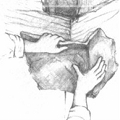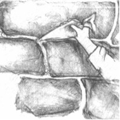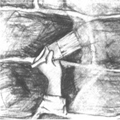|
Step 1 :
With a plasterer's trowel apply 1 layer of adhesive mortar 1.5
cm thick to the wall. Make sure not to spread mortar over an area too large in order to avoid drying and resulting loss of
adhesion before the stones are fitted.

Step 2 :
Our stone can be fitted from the top down or from the bottom up.
Installing CraftStoneTM from the top down helps keep the stone clean from dripping mortar. Start by applying corner elements
first. Note that corner elements have a long and a short side, which should alternate on the corner. Cover the backside of
each individual stone with adhesive mortar and press it into the mortar bed until mortars squeezes out around the stone's
edges. Remove excess mortar using mason's trowel.

Step 3 :
Install flat stone elements from corner to center making sure
that uniform joints of 1 cm or less are kept between the stones. Avoid long, unbroken joint lines between the stone elements.
As on the corner elements, apply a generous amount of mortar on the back side and press the flat stone into the mortar bed
and remove excess mortar around the edges, cut and trim stones with a hatchet or wide mouth nipper to obtain custom sizes
as needed. For best finished appearance cover cut edges with mortar.

Step 4 :
After all stone elements have been fitted to the wall, fill the
joints with mortar using a grout bag. Avoid smearing any mortar on the surface of the stones. Accidentally smeared stone should
be allowed to dry until crumbly and then brushed off with a whisk-broom. Do not let loose mortar dry overnight. Do not use
acid or acid based products.

Step 5 :
When the mortar joints have become firm but not dry, rake out
excess mortar and point up joint using a wooden stick or a metal pointing tool. Carefully seal the stones around the edges.
Clean joints and loose mortar on the surface of the stones with a whisk-broom. Do not let loose mortar dry overnight. Do not
use acid or acid based products.

Step 6 :
If required to seal the stone use a good quality masonry sealer
(to minimize possible staining). Use silicone or silene based products. Be sure to test these products on loose stones before
application (for color range) as certain sealer will darken or affect the stone’s colors.

|

